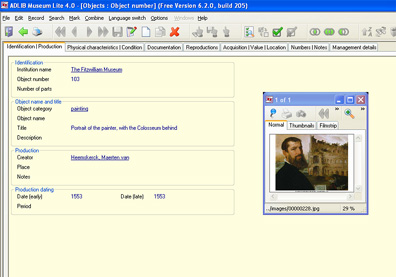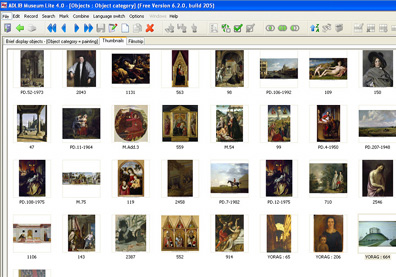
Figure 1: The screen layout showing the menu bar and an example item from the objects database
Curator of Access, Archaeology, York Museums Trust, St Mary's Lodge, York YO30 7DR
Cite this as: Morrison, A. 2006 Review of Adlib Museum Lite software, Internet Archaeology 19. https://doi.org/10.11141/ia.19.7
Adlib Museum Lite is a free download from Adlib's website (after registration). Adlib Museum Lite requires Windows 2000 or XP running on at least 400 MHz Pentium II PC with at least 64 MB of RAM. Available: http://www.adlibsoft.com
ADLIB information systems have brought to the UK marketplace a free fully functioning, Spectrum-compliant, database package aimed at museums and private collectors. Adlib Museum Lite is based on 'its bigger cousin' Adlib Museum, used by museums worldwide, ranging from Heritage Centres to National Museums.
The download file is not small at 100mb and took 10 minutes to download in the middle of the day with a broadband connection. Once downloaded the install wizard is simple to follow and takes no time at all, including an option to install demo data. An online manual in the form of a .pdf file is also installed.
The screen layout resembles many other database packages. A menu bar at the top of the screen has large colourful buttons and a series of pull-down menus (Fig. 1). The software is based on five linked databases: Objects, Documentation, Visual Documentation, Persons and Institutions, Thesaurus and Currencies. The objects database is the central dataset for the software. The others, mainly, provide reference datasets, created by the user, and used in the records in the objects database. The data recorded in each record in the 'Objects' database is split over seven screens: Identification/Production, Physical Characteristics/Condition, Documentation, Reproductions, Acquisition/Value/Location, Number/Notes and Management Details. Moving between the fields in each screen using the TAB key makes data entry easy and relatively speedy. Navigating between the screens is, likewise, simply done by clicking on the appropriately labelled tab.

Figure 1: The screen layout showing the menu bar and an example item from the objects database
Overall, however, there are some issues that make Adlib Museum Lite imperfect. Spreading the 56 fields over seven screens ensures that each screen includes a lot of empty space. Perhaps consolidating some of these screens to include, for instance, 'material' to be alongside object identification and production fields on the first screen would make sense. Also the 'description' field on this first screen seems to be duplicated by another, but unlinked, 'Physical Description' field on the next screen. Images are displayed in a window floating over the first screen. Yet this window disappears when changing screen, so there is little sense in having this second 'Physical Description' on a screen without an image.
The biggest surprise is the lack of any fields for recording field collection data. This, to me as an archaeological curator, makes the software pretty much useless, as it probably would be for any collections where context and provenance are important. Of the 184 supplied demo records, the vast majority consist of paintings and photographic images and negatives. This perhaps suggests that the software developers are aiming the software at these particular collection areas.
All five databases follow the same 4-step search wizard: select database, select access point (a field within a database), enter search criteria and display results. Each field in each database is searchable, producing a powerful search tool. My first search with a blank entry in the object number field returned (according to its own report) 184 records in 0.04 seconds yet the object numbers listed totalled only 100 records. The missing 84 records magically appear by pressing the down arrow key or selecting the grid display, although this is not specified (Fig. 2).

Figure 2: The screen layout showing the results of a search, which are displayed in a grid format called a 'thumbnail' view
Overall, Museum Lite does not seem to be a database appropriate for archaeology collections and it shares some of the peculiarities of its 'bigger cousin' that, as a user, tend not to fill me with confidence. Those wishing to include field collection data (essential for most archaeological objects) as part of their documentation will have to choose the full version of Adlib Museum. Adlib Museum Lite will not be sufficient for most projects.
From:
Bert Degenhart Drenth, General Manager, Adlib Information Systems.
Sent Mon, 3 Jul 2006.
For the benefit of your readers, we'd like to correct a couple of misconceptions about the operation of the software raised by the reviewer:
However, we acknowledge that the lack of a 'field collection' recording screen tab does impair the software's usefulness to the archaeological community, and so we have decided to revise the application to now include this functionality. This new release of Adlib Museum Lite will made freely available on our website http://www.adlibsoft.com from August 2006.
Kindest regards,
Bert Degenhart Drenth
Internet Archaeology is an open access journal based in the Department of Archaeology, University of York. Except where otherwise noted, content from this work may be used under the terms of the Creative Commons Attribution 3.0 (CC BY) Unported licence, which permits unrestricted use, distribution, and reproduction in any medium, provided that attribution to the author(s), the title of the work, the Internet Archaeology journal and the relevant URL/DOI are given.
Terms and Conditions | Legal Statements | Privacy Policy | Cookies Policy | Citing Internet Archaeology
Internet Archaeology content is preserved for the long term with the Archaeology Data Service. Help sustain and support open access publication by donating to our Open Access Archaeology Fund.